The name of Lyon’s 24-year-old central midfielder, Bruno Guimarães (182cm/6’0”, 78kg/172lbs) is one that’s been mentioned a lot in recent weeks with regard to an upcoming transfer away from Groupama Stadium and Ligue 1, with EPL side Arsenal said to be interested in securing his services.
The Brazil international made his initial move to Europe in this window two years ago when he joined Lyon from 2021 Copa Sudamericana champions Club Athletico Paranaense for a reported €20m. At the time, Arsenal were also said to be one of the club’s monitoring Guimarães, along with La Liga’s Atlético Madrid. However, it was Lyon who successfully brought the midfielder to Europe but now, with Lyon in the midst of a disastrous campaign by their standards, Guimarães’ name has been linked with the exit door.
I wrote about the long-term Arsenal target two years ago, in a tactical analysis piece that can be read here: Bruno Guimarães 2019/20 – scout report. In that analysis, I detailed three key strengths in the midfielder’s game, with a focus on his ability to progress the ball via dribbling, his long passing quality and his defensive abilities. These three areas have remained key parts of his game over the last two seasons in Ligue 1, with Guimarães showing that he’s more than capable of performing for a top club in one of Europe’s top-five leagues.
Famed Italian transfer expert Fabrizio Romano recently commented on the speculation around Guimarães’ future by stating that as far as Les Gones are concerned, it’s “€45m or nothing” for Guimarães this transfer window, which the journalist indicated could make a transfer switch unlikely for the player this month. However, regardless of touted price tags, I feel the speculation around Guimarães is more than justified this month based on his performances for Lyon since arriving two years ago.
In this scout report, I’ll provide analysis of Guimarães’ role in Lyon’s strategy and tactics, while highlighting key strengths and potential areas of improvement in the player’s game. The midfielder has grown during his time at Lyon and based on the club’s current standing in France’s top-flight, it’s difficult to argue that Guimarães shouldn’t be aiming to secure a step up in level. For me, Guimarães is currently the best central midfielder in Ligue 1 not playing for PSG. He’s a well-rounded box-to-box presence who does everything you’d want your central midfielder to do very reliably. I hope that this scout report adequately explains why I believe this to be the case. All stats and data used in this analysis come from Wyscout unless otherwise stated.
Passing and retention
Guimarães is typically heavily involved in Lyon’s build-up and ball progression phases. In this section, I’ll analyse his off-the-ball movement, scanning and technical passing abilities to show why this is the case and how he puts these qualities to good use to help his team in early possession phases. A lot of Lyon’s play typically goes through Guimarães, with the midfielder playing a role that sees his side rely on him to circulate possession and for ball retention, as well as progression.
The Lyon man has played a very high 68.31 passes per 90 this term while retaining 89.23% pass accuracy. His performance in both of these areas ranks him very highly among the 85 central midfielders/holding midfielders to have played at least 400 minutes in Ligue 1 this term. Additionally, these two statistics tell us a lot about his heavily involved role in early possession phases for Les Gones and how his team relies on his ball retention abilities in the build-up and ball progression phases when circulating possession in search of progression opportunities.
Guimarães is an excellent asset for ball progression too, which we’ll analyse later in this scout report, but a key thing to note about him is how he can be relied upon to not force the issue and continue circulating the ball while waiting for an opening when required. Guimarães is incredibly technically sound in terms of his ability to receive the ball well and calmly, as well as perform the passing basics to a high level consistently. Even when under pressure, with the ball moving at a fast pace and when afforded little thinking time, Guimarães reliably makes good, safe decisions when circulating possession and, importantly, executes his decisions crisply with good technique. He very rarely makes any avoidable mistakes in these situations which is why his team relies on him so heavily in these phases to perform this role.
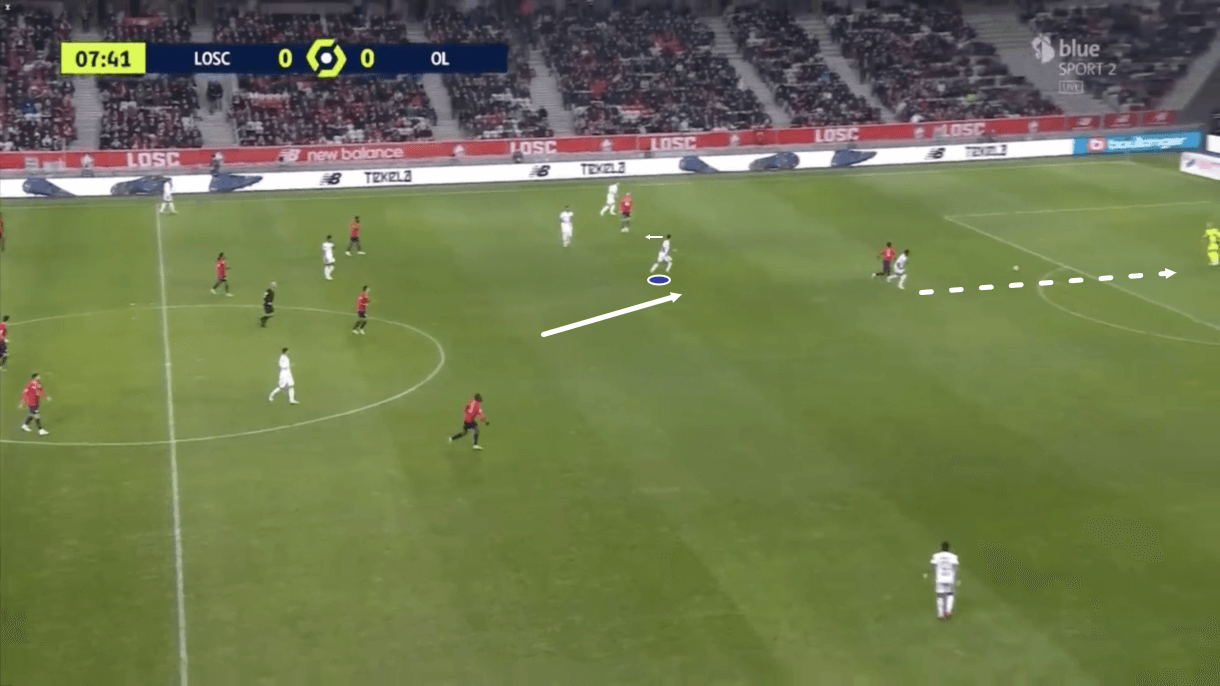
Figures 1-4, all from the same passage of play, highlight Guimarães’ scanning, off-the-ball movement and technical quality. I felt that this particular passage of play does a good job of summarising what Guimarães is in the early possession phases of play, if concerned with his passing and ball retention qualities. Firstly, figure 1 shows Lyon’s goalkeeper receiving the ball from a centre-back under pressure while Guimarães is in the process of dropping deep from the left holding midfield position that he typically occupies in Lyon’s 4-2-3-1. The Brazilian is very comfortable with dropping deep in the build-up, either to give his centre-backs a short forward passing option or even to add another body to the backline, which was the case here, to give his goalkeeper another option and outnumber the opposition’s press in this first line.
The midfielder’s scanning is very notable in this passage of play and we see one instance of it in figure 1. Here, Guimarães is dropping deep while checking his left shoulder at the correct times (in between his teammates’ touches while the ball is moving and not drastically changing direction) to 1. Get as much information as possible about the lay of the land around him to ensure he has a good picture of the pitch in his mind which will then help his decision-making and 2. To keep himself aware of incoming opposition pressure so he can react to it with his movement and not get caught in possession in a very dangerous position here.
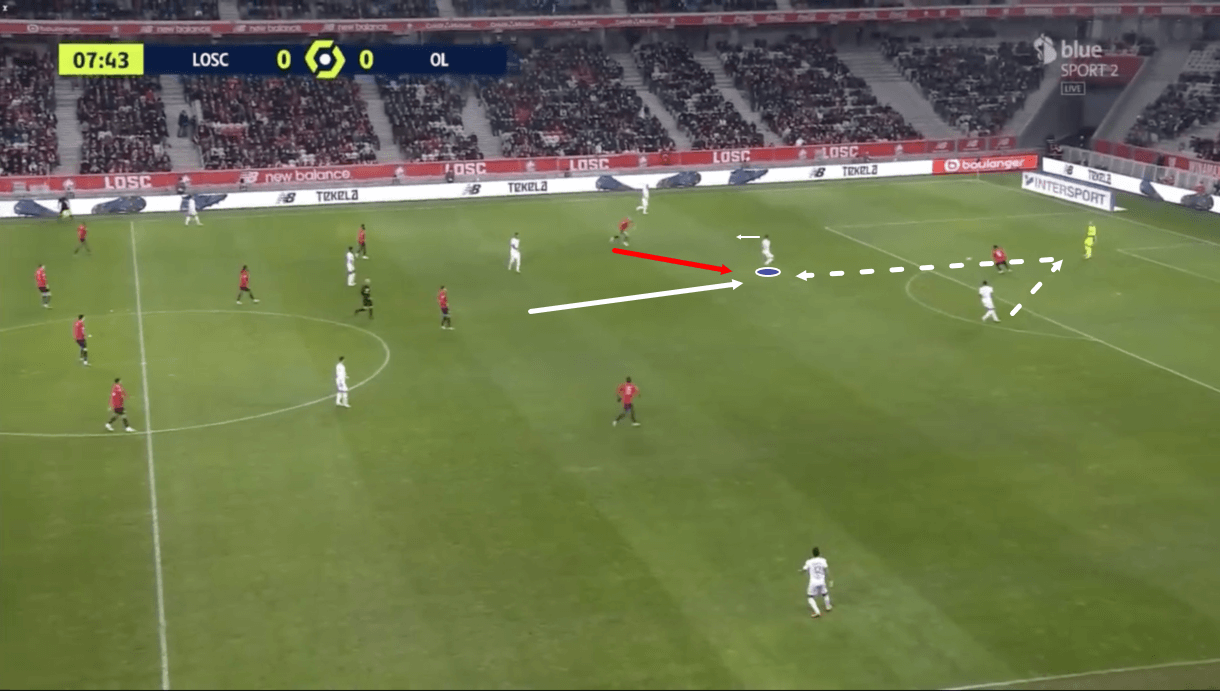
Between figure 1 and 2, Guimarães scanned once more for the same reasons and as play moves on into figure 2, we see the player scanning once again — this time after the ‘keeper played the ball to him and while it’s moving towards him. Again, this shows intelligent and effective scanning from the midfielder. He goes on to receive the ball well on his left foot as play moves on. Thanks to his scanning, he was aware of the incoming pressure from the opposition’s left-forward and reacted to it accordingly.
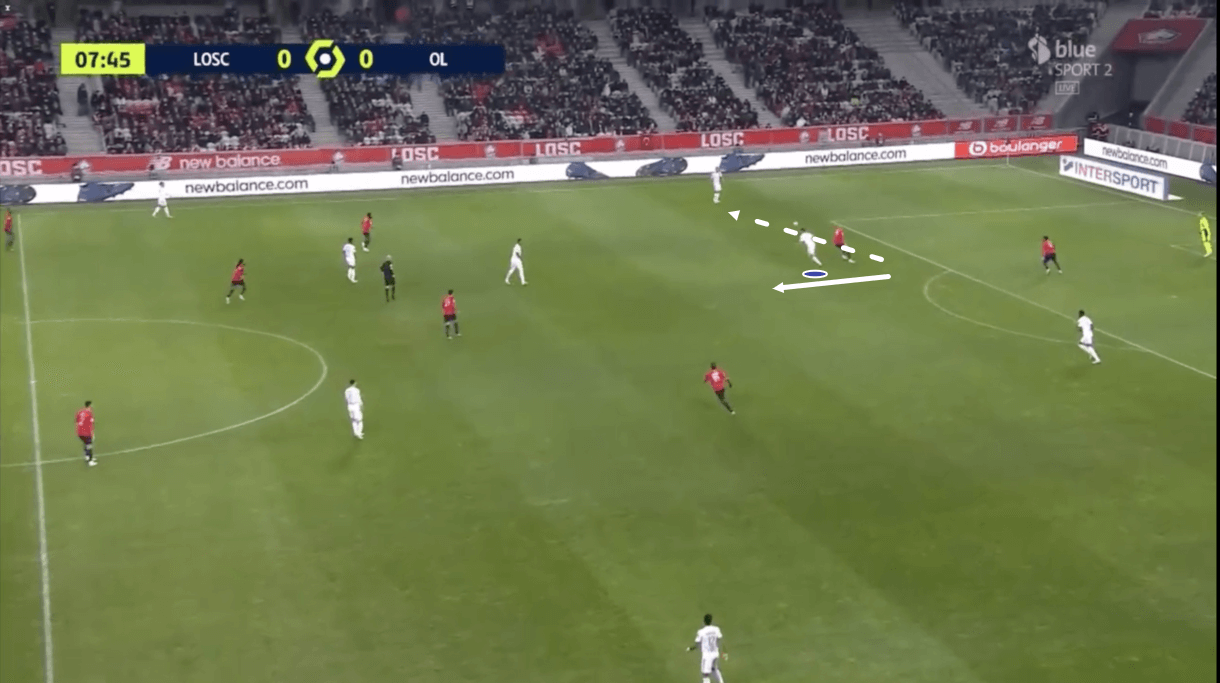
Guimarães acted as he often does when under pressure — allowing the opposition defender to get close with his pressing before knocking the ball away from him — a plan he was able to execute perfectly thanks to his prior scanning and excellent technical quality. According to Statsbomb via FBRef, when compared with other midfielders from Europe’s top-five leagues, the Brazilian actually ranks in the 99th percentile for passes under pressure, highlighting how common it is for him to be in situations such as the one we see above.
Just as the opposition defender arrived at Guimarães, the midfielder passed the ball out to his right-back teammate who was free from pressure. The right-back isn’t occupying a very threatening position on paper here, but thanks to Guimarães’ pass and subsequent quick movement beyond the pressing player — which is evident in figure 3 — this pass did help Lyon to get past two opposition players in the first line of their press and created a great opportunity for Guimarães to receive the ball back from the right-back again in a far more threatening central position — an area of the pitch in which Les Gones have plenty of bodies in space at this point.
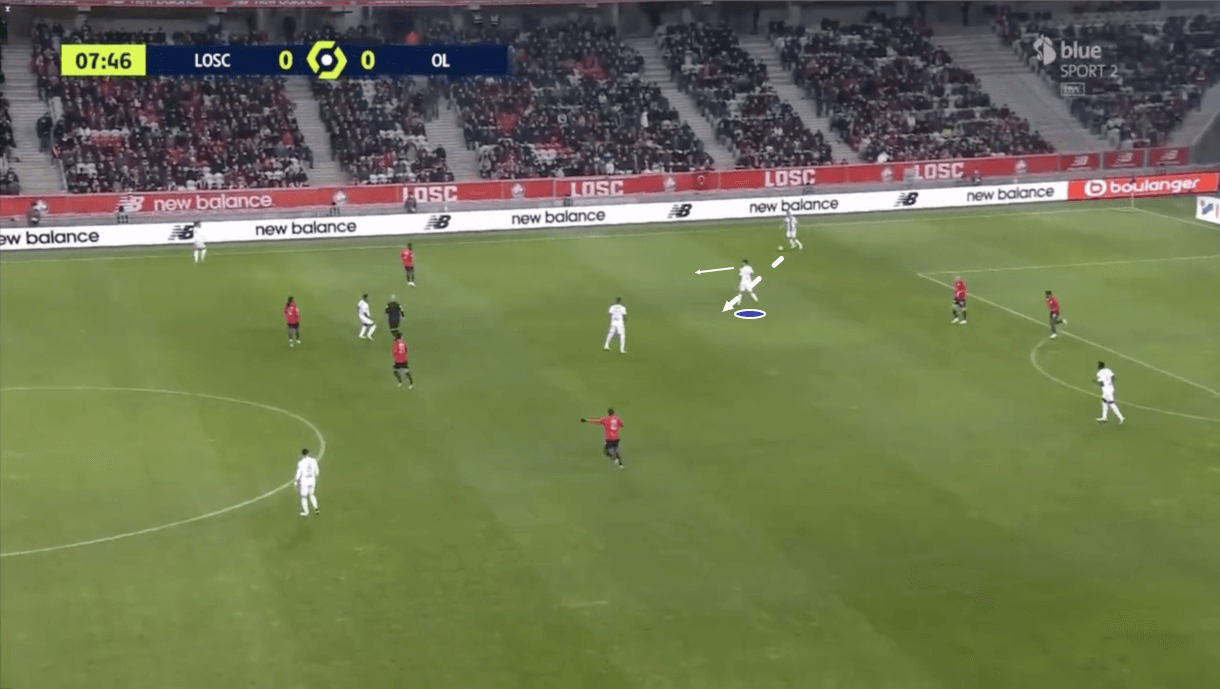
As play moves on into figure 4, again we see Guimarães occupying this central position, scanning his left shoulder before receiving the ball back from the right-back. This image makes it even clearer how Guimarães’ previous work helped his team to beat the opposition’s first line of pressure and as play moves on from here, we see the Brazilian pick the ball back up, in plenty of space, in central midfield with plenty of central passing options ahead of him to take his team further upfield, into the opposition’s half.
The qualities that Guimarães exhibits in this passage of play and the player’s ability to consistently perform like this to such a high level shows exactly why he’s such an excellent asset for his team in build-up and ball progression. He’s a great asset for ball retention and for linking up with teammates under pressure to help play out of tight spaces.
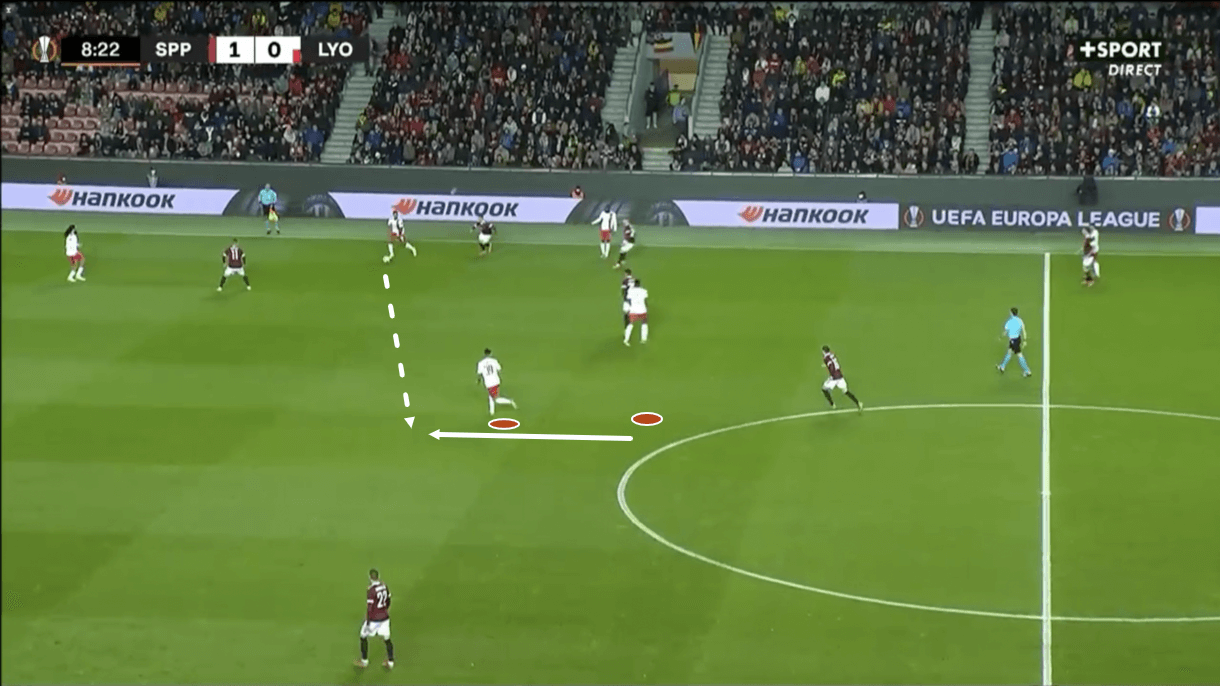
Figure 5 shows another example of how Guimarães uses intelligent off-the-ball movement to create space for himself and support teammates during the early possession phases. Just before this image, Lyon’s left-winger passed the ball back to their left-back who came under plenty of pressure. At this point, Guimarães quickly sneaked into a deeper position, creating some increased separation between him and the nearest opposition midfielder and making himself an easier and more attractive passing option for Lyon’s left-back. We can see another example of the 24-year-old scanning over his right shoulder in this image, to ensure the nearest midfielder isn’t tracking him too closely, which he wasn’t thanks to the Brazilian’s intelligent and subtle movement.
Again, this shows exactly why and how Guimarães is so heavily used in Lyon’s early possession phases — he’s great at making himself a more attractive and easier passing option through his off-the-ball movement. Then, he’s technically sound enough to be very reliable after receiving the ball, while his subsequent decision-making is also aided by his effective scanning.
Long passing remains a prominent part of Guimarães’ game just as it was before joining Lyon two years ago. This season, the midfielder has played a very high 4.74 long passes per 90. Guimarães plays plenty of long through balls over the top for runners to chase in behind the opposition’s backline, and these higher-risk, higher-reward style long passes will impact his long pass accuracy. A lower pass accuracy isn’t necessarily equal to ‘worse passing’, though, as these lofted through balls over the top are valuable in that they create goalscoring chances. This style of pass forms an important part of Guimarães’ attempts at chance creation.
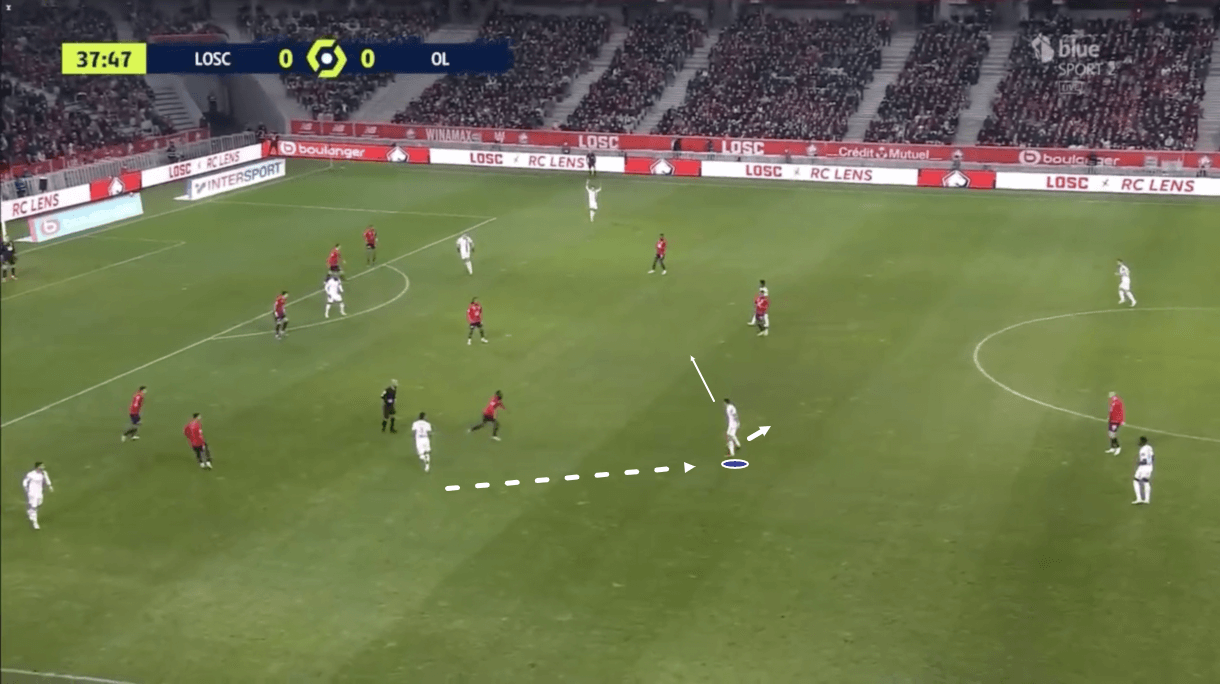
Switching play also takes up a notable part of Guimarães’ long passing. It’s common, in both the progression and chance creation phases, to see Guimarães picking up the ball deep, in space, before playing a switch to a free man out wide who can then test the opposition’s backline. The midfielder’s off-the-ball movement to find space, consistency at receiving with an open body shape, vision and technical passing quality all combine to make Guimarães a valuable player in such situations. Figure 6 above shows an example of Guimarães receiving the ball in his deep left-sided midfield position during the chance creation phase with his team looking to break into the opposition’s penalty area. Here, we see Guimarães receiving the ball well on his right foot with an open body shape while surveying the passing options ahead of him. In figure 6, we see his eyes locking onto the wide passing option on the right-wing in plenty of space to receive.
On receiving possession and picking out his intended target, Guimarães knocks the ball to his right while positioning his body between it and the incoming defender pressing him from midfield. It’s very common to see the Brazilian doing this and putting his left arm out to protect the ball from the incoming opposition pressure.
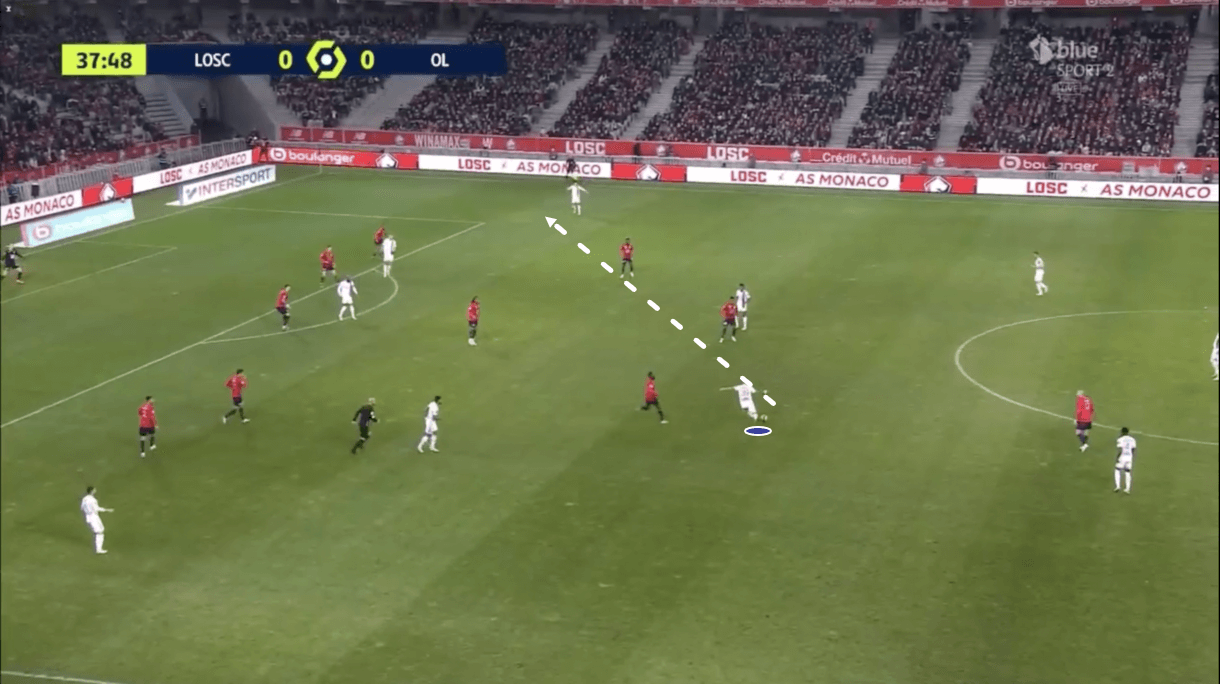
He continues to keep the ball here while lining up his pass and eventually playing it, as we see in figure 7. From here, Guimarães drives the ball in front of the intended receiver, allowing the wide attacker to run onto the ball and attack the opposition’s backline. This highlights the benefit for Lyon in having such a technically sound deep-lying playmaker on the pitch. This long passing quality, along with the rest of Guimarães’ technical and mental abilities that were on show here, is an important part of his game and contributes greatly to the Brazilian’s overall threat on the pitch.
Dribbling and adding threat
Guimarães’ ability to progress the ball via his dribbling has also always been a key part of his game and remains so. For me, his progressive carrying is even more impressive than his progressive passing, the latter of which we’ll get to later and is also an impressive part of the Brazilian’s game. However, Guimarães is a very threatening dribbler and I find this attribute of his to be his most exciting one.
The Lyon man ranks very highly in terms of dribbles per 90 among Ligue 1’s central midfielders / holding midfielders to have played at least 400 minutes this season, making 4.67 per 90, while he’s also managed to retain a solid 57.33% dribble success rate. Furthermore, he’s engaged in a very high 10.41 offensive duels per 90, with an offensive duel basically being defined by Wyscout as either a dribble or an instance of the carrier guarding the ball from his opponent with his body. These are always paired with defensive duels from the defending player/team. The Brazilian has a solid 55.69% success rate in offensive duels this term too, which also ranks well amongst Ligue 1’s other central midfielders.
Lastly, per Statsbomb via FBRef, when compared with midfielders in Europe’s top-five leagues, Guimarães ranks in the 98th percentile for progressive carries, which basically tells us that when compared with other top midfielders in Europe, Guimarães is extremely active in successfully moving the ball towards the opposition goal via his dribbling, which is a very valuable skill for his team and one that constantly increases the threat they pose.
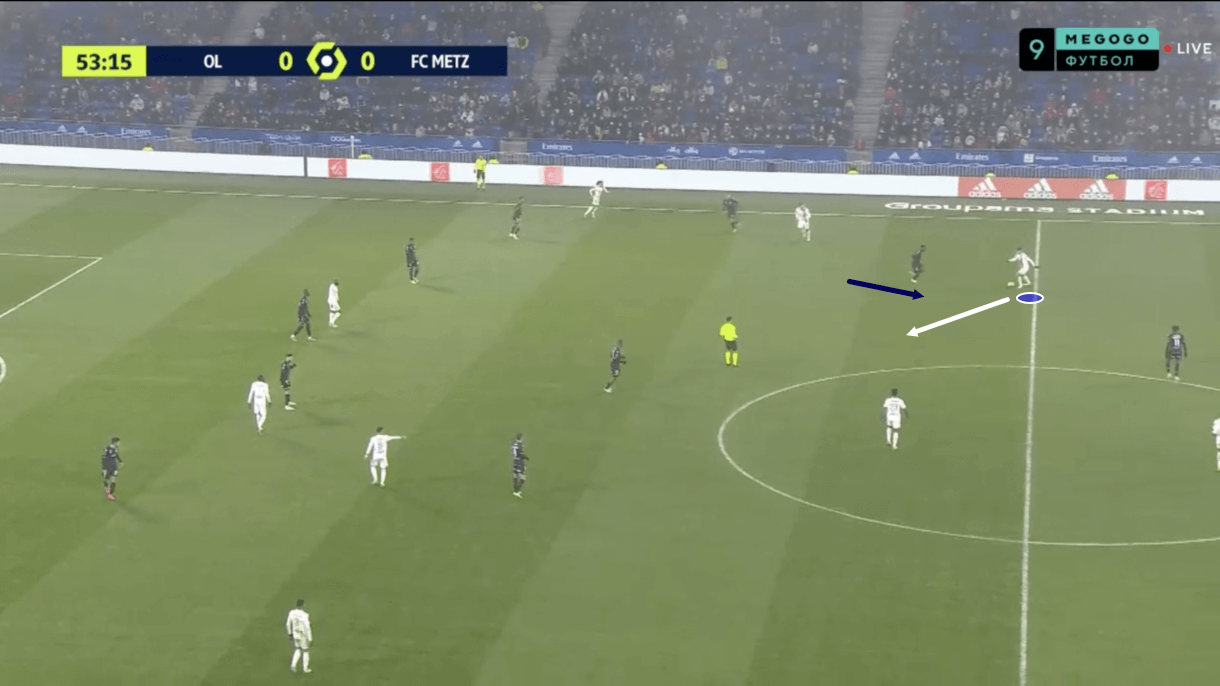
Figures 8-10 present a passage of play that highlights Guimarães’ progressive carrying ability in action for Lyon. Firstly, figure 8 above shows Guimarães on the ball having just received possession on the halfway line. On receiving the ball in space in his deep, central midfield position, as is common, he draws some pressure from the nearest opposition midfielder who pushes up from his own deep position to close down Guimarães.
The Brazilian is very comfortable in such situations. He loves drawing opposition players in very close after receiving the ball before then either releasing to a teammate or knocking the ball past them to chase. He’s very athletic with excellent acceleration which helps him when looking to burst past on his own, while his impressive strength also helps in such situations to hold opposition defenders off and protect the ball. Guimarães also possesses impressive balance, even when under pressure from opposition defenders. This helps him to remain on course and in control of the ball even when the opposition defender is attempting to dispossess him during his dribble.
Per Statsbomb via FBRef, when compared with other midfielders from the top-five European leagues, the 24-year-old ranks in the 90th percentile for ‘players dribbled past’ and the 97th percentile for ‘fouls drawn’. Both of those percentile rankings are a direct result of Guimarães’ tendency to draw players in like this very closely before making his next move. His ball control, agility, balance, strength and acceleration all combine to help him succeed in either beating players or drawing fouls in such situations, as opposed to just being dispossessed. This makes the action very effective and beneficial.
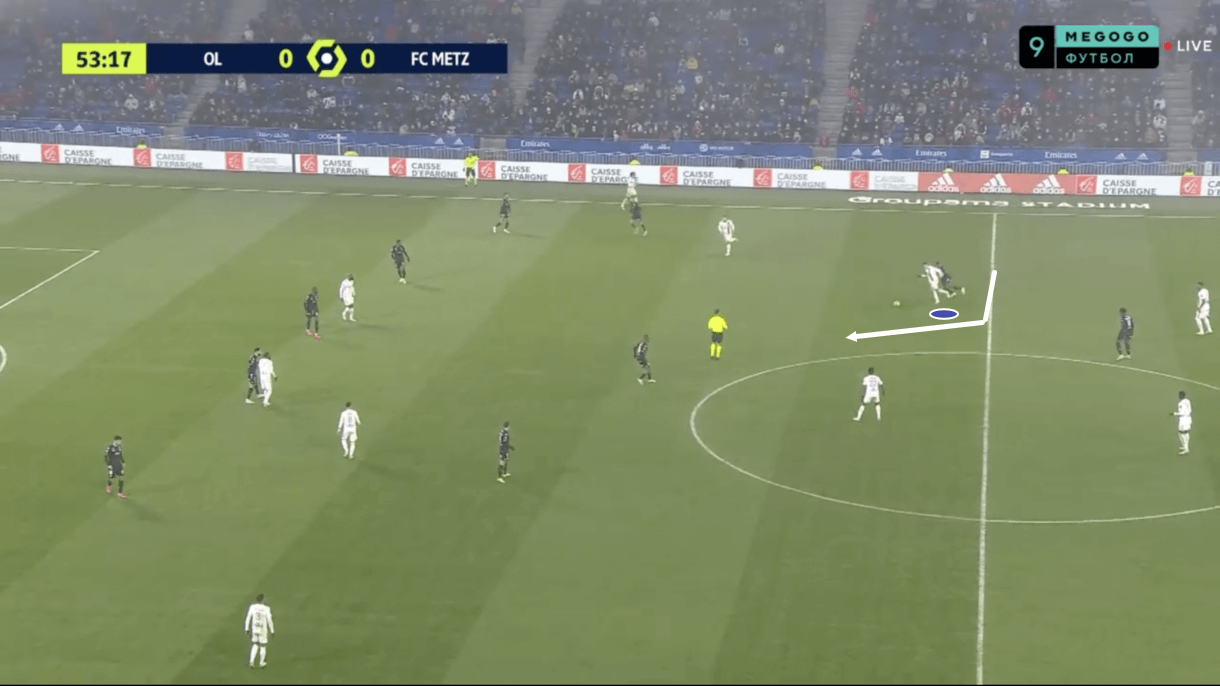
As play moves on from figure 8 into figure 9, we see how Guimarães waited for the defender to get close on this occasion before successfully bursting past him on the inside. His ball control, agility and balance were then key for retaining possession while changing direction during his dribble.
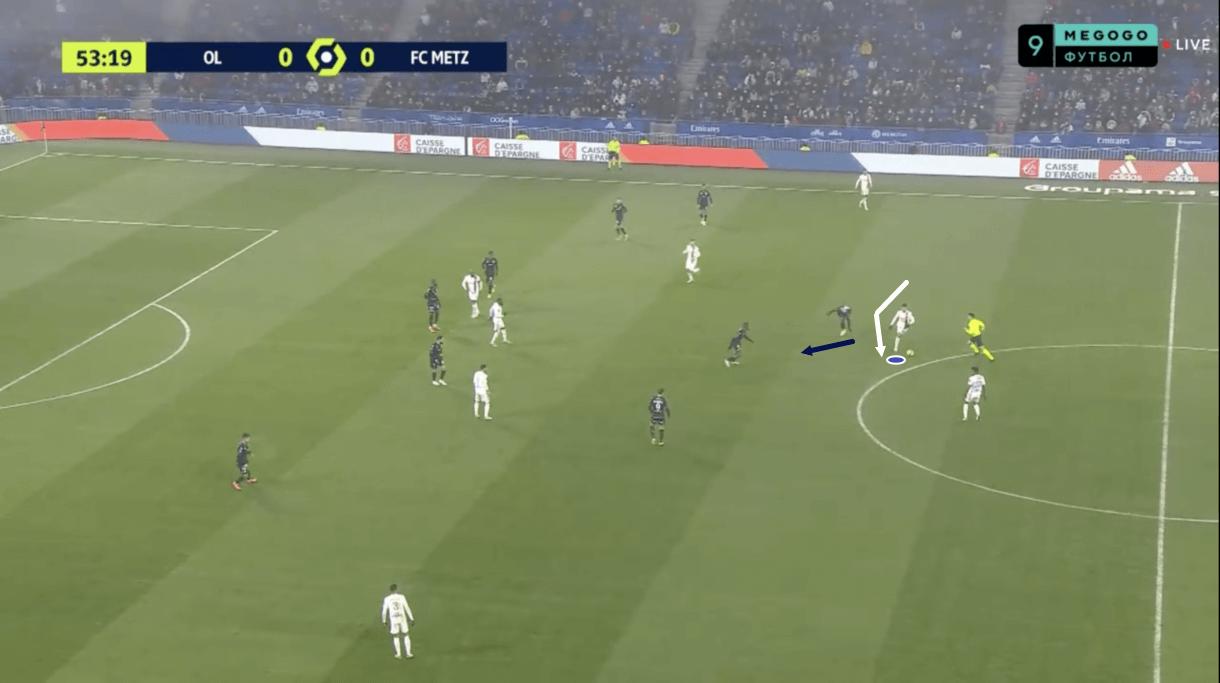
As Guimarães progressed past the opposition midfielder, the defensive player remained close-by, in pursuit of the Brazilian to try and dispossess him or at least make his continued progress more difficult. By the time the passage of play progressed to the point we see in figure 10, however, the ball carrier successfully shook the midfielder off. Part of this is down to Guimarães’ strength to hold off the midfielder in the first place but Guimarães’ agility, balance and ball control all played key roles in helping him to achieve this too.
The Lyon man succeeded in losing the defensive player in pursuit by turning sharply while carrying the ball forward at pace. While Guimarães made this turn without issue while retaining control of the ball, the opposition midfielder perhaps didn’t anticipate the movement so well and was thrown off course, losing balance and losing track of Guimarães. From here, another opposition midfielder was dragged out of position to close down Guimarães and deny him enough time and space to create from deep, but this then created space for another Lyon player to exploit and as play moves on from figure 10, we see Guimarães release to the midfielder beside him who receives the ball in a more advanced central position than where Guimarães was back in figure 8 — highlighting the value of the Brazilian’s time on the ball — and who receives the ball from Guimarães with plenty of space to run forward into thanks to the Brazilian’s work in attracting another opposition player towards him.
It’s common to see Guimarães carry the ball forward into more threatening positions like this before releasing to a teammate — even via a simple pass, as was the case here.
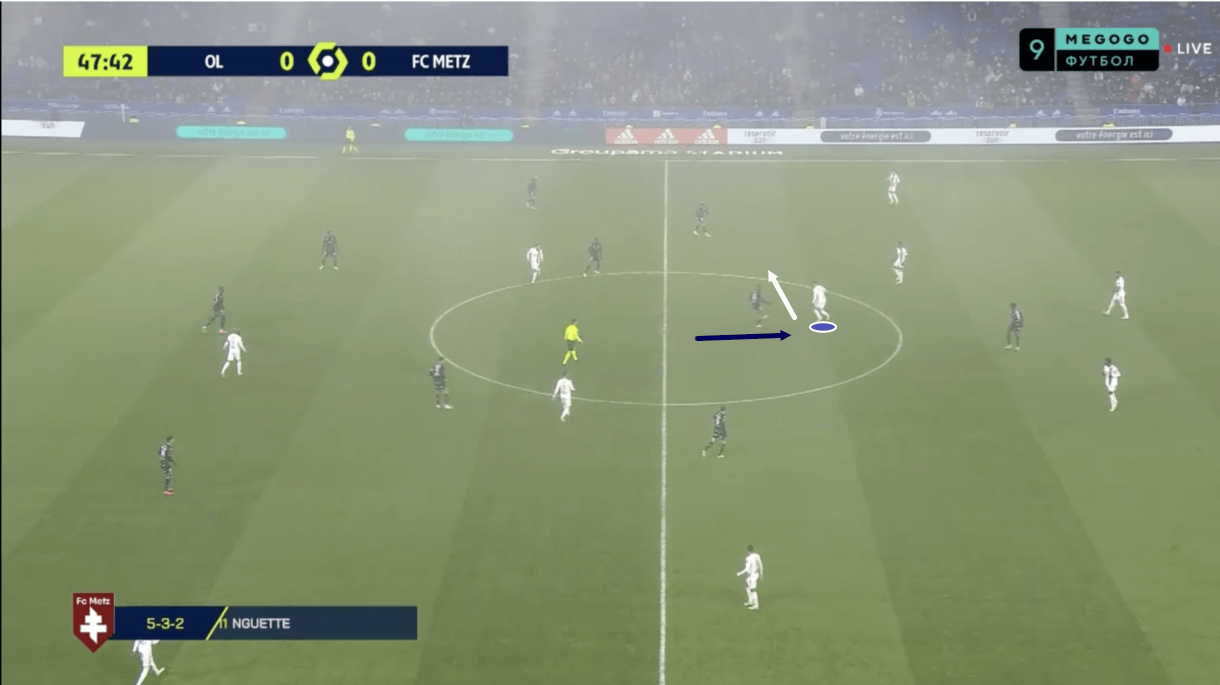
At times, Guimarães’ value as a ball carrier isn’t even as ‘obvious’ as it was in the previous passage of play where he went on a long forward run during which he beat and then shook off a defensive player before releasing. These runs are common in his game and are very valuable, but Guimarães’ ball-carrying quality and ability to guard the ball from pressing opposition players is evident at times when not carrying the ball over long distances too, which the passage of play in figures 11-12 highlights.
Firstly, figure 11 shows Guimarães in possession just inside his own half, with the opposition’s right central midfielder drawn out to press him. No clear forward passing options are evident for the midfielder at this moment but with a backwards pass at this moment likely resulting in the opposition pushing up together to apply further pressure to Lyon’s backline, the 24-year-old instead opts to rely on his dribbling and ability to guard the ball from the pressing man with his body. It’s thanks to his impressive physical traits (speed, balance, agility, strength) and stellar ball control that this option is such a viable one for Guimarães in such situations. He’s very comfortable backing himself when confronted like this and is capable of finding a good solution by carrying the ball for a bit longer.
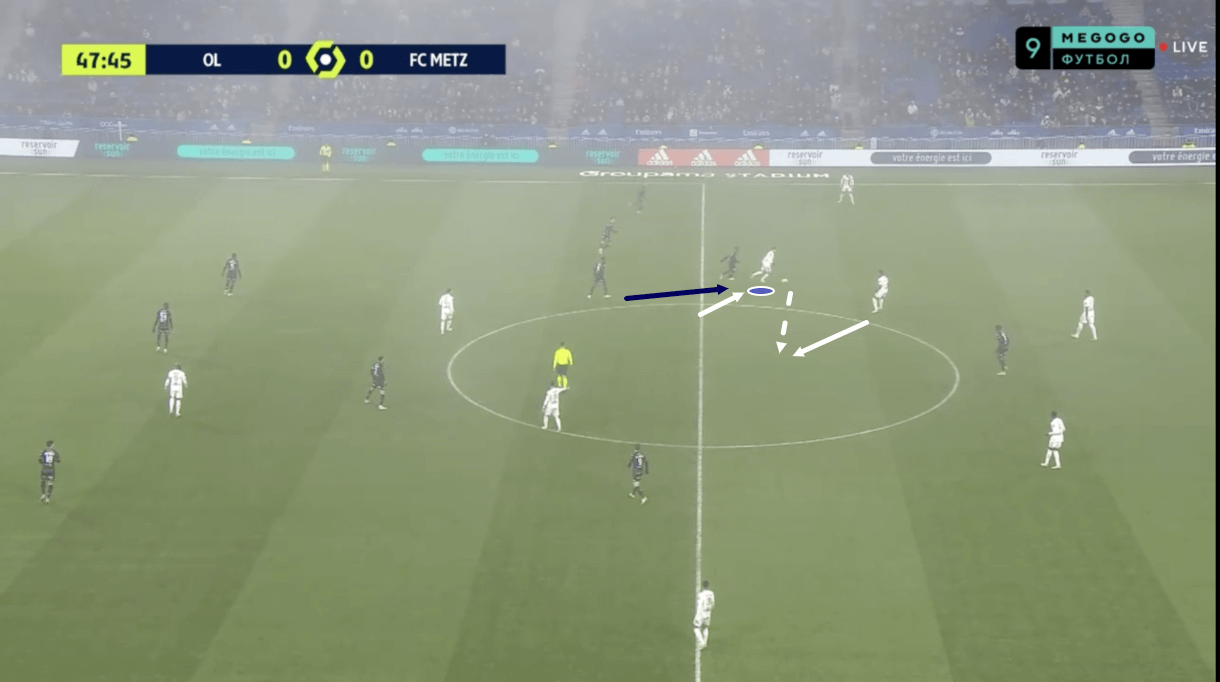
As this passage of play progresses to figure 12, we see that while Guimarães wasn’t able to carry past the pressing player right away, he was able to retain possession while carrying and protect the ball via his body, which is now between it and the pressing player. We see that Guimarães has drawn the right central midfielder away from his base position towards the left side of the pitch through his carry and this created space for another Lyon player to push forward into their left central midfield position and exploit the opposition midfielder for getting drawn out of position by Guimarães like this.
As play moves on, we actually see Lyon’s right centre-back push forward into this space, with Guimarães dropping into a temporary left centre-back position. This intelligent rotation which followed Guimarães’ clever carry allowed Lyon to cut through the opposition’s midfield despite Guimarães having started this move without a lot of decent passing options. Again, this highlights the value of the midfielder’s ball carrying quality and how it helps him to add to the threat his team poses, even if he’s not increasing the threat directly via a progressive carry or pass. Here, Guimarães added threat by dragging a player out of position via his carry, protecting the ball and releasing to a player in space who could then drive the team forward. This is a very important part of Guimarães’ game. It’s not always just about him driving the team forward, he helps his teammates to do so a lot as well. In that sense, he’s a very unselfish player with excellent vision and understanding of space in midfield.
Progressive and creative passing
Guimarães has made 3.61 successful attacking actions per 90 this season, which ranks highly among Ligue 1’s central / holding midfielders with at least 400 minutes. He’s managed to generate 1.01 xG from a low 0.62 shots per 90, while he hasn’t actually scored this term. As his low shot count indicates, Guimarães’ main contribution in the final third and to successful attacking actions doesn’t come from direct threats to goal. He tends to operate in a deep-lying role just in front of the backline / on the edge of the final third when his side is in the chance creation phase. Here, he is good at finding space to create from deep if his team needs to use him.
Occasionally, Guimarães does take on long shots. He’s not afraid to back himself from range if the shooting opportunity presents itself. However, his record from long shots isn’t great this term and he’s skied the ball a few times. All in all, I don’t think his decisions to shoot from range are generally good ones and he might be better avoiding shooting from range altogether and just focusing on what he’s best at — carrying and passing — when he gets possession in the chance creation phase. This isn’t to say Guimarães should give up trying to add more goals to his game altogether, but he should look for other ways to achieve this such as improving his better off-the-ball movement to arrive late into the box which could see him enjoy shooting opportunities from higher-value positions.
We’ve already looked at how Guimarães uses his dribbling ability to drive his team upfield and into the opposition’s half and he also uses this ability to progress his team into the final third a lot. He often combines this with his passing ability and we’ll look at an example of how he often does this in figures 13-14.
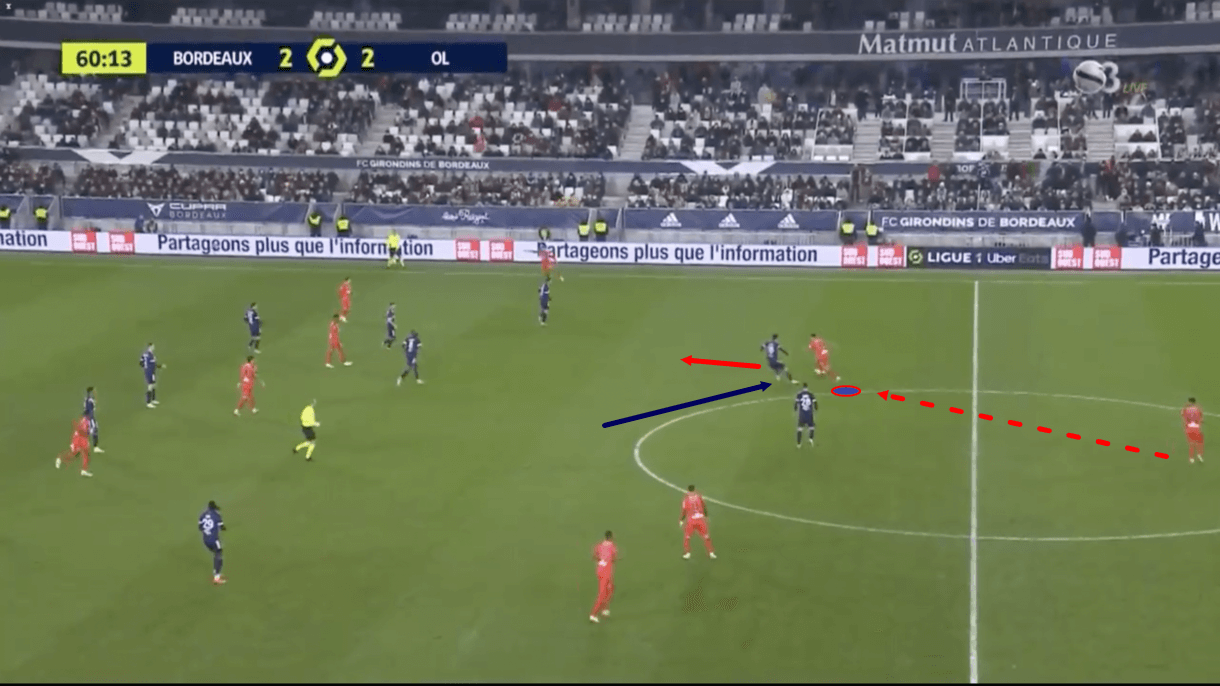
Figure 13 shows an example of Guimarães picking the ball up just inside the opposition’s half during the progression phase with lots of teammates ahead of him in space to potentially receive and attack the opposition’s backline. On receiving the ball, however, the Lyon man comes under some pressure from an opposition midfielder who immediately looks to close him down. Having previously scanned very effectively before receiving the ball well on the half-turn, however, Guimarães anticipates the defending player’s incoming pressure and prepares to react accordingly.
As we’ve established, Guimarães is very comfortable with allowing opposition defenders to get very close before making his next move — he’s good in these situations because of his frequent effective scanning and the previously mentioned physical and technical attributes in his game. We see another example of the Brazilian allowing the opposition defender to get very close before making his next move in figure 13.
As he does decide to make his move, we see Guimarães burst forward into space on the right side of central midfield. His touch is well-weighted and this, combined with his acceleration, helps him to dart past the pressing player to drive forward with the ball.
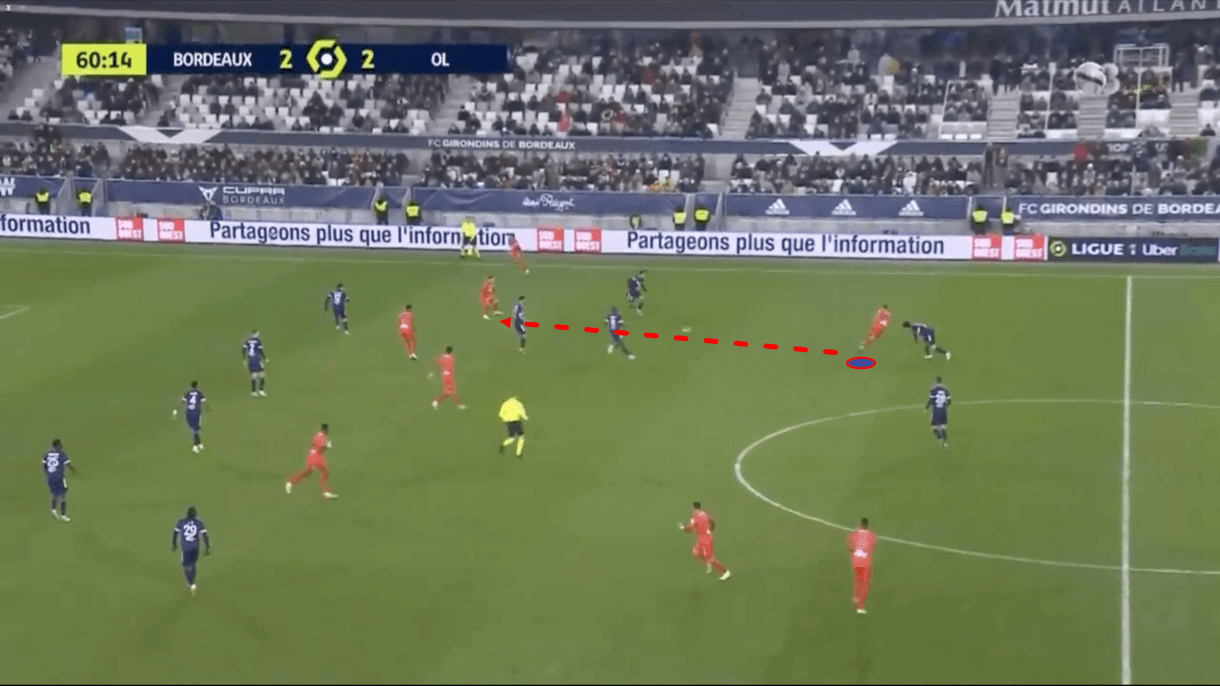
His little carry forward here was good enough to leave the pressing player unbalanced and out of the way, giving Guimarães plenty of time to weigh up his next move. Before long, we get to figure 14 where we see Guimarães slice the opposition’s defensive shape open with a line-splitting progressive pass to a teammate in the right half-space who then manages to link up with an overlapping teammate on the right, overloading the opposition’s left-back and breaking into the final third. This is an exact move that’s very common in Guimarães’ game — we often see him pick the ball up deep in the progression phase, draw pressure from a defending player, burst past them into space and then release into the final third via a well-weighted and accurate progressive pass.
It’s similarly common to see the midfielder perform the initial move from figure 13 before releasing to a runner threatening space behind the opposition’s backline via a defence-splitting through ball. These two passes, following the initial burst past the pressing player, are very common tools in Guimarães’ skillset.
Guimarães has actually played the fourth-most passes to the final third (11.41 per 90) of any Ligue 1 central midfielder/holding midfielder to have played at least 400 minutes this term, along with a high number of through passes (1.87 per 90) for a Ligue 1 central midfielder. Furthermore, to highlight how prominent progressive passing is in the 24-year-old’s game, he’s also played the fifth-most progressive passes (9.35 per 90) of any Ligue 1 central midfielder/holding midfielder with at least 400 minutes this term, and he’s retained a highly impressive 86% success rate with those progressive passes in the process, showing that he’s not just playing a lot of progressive passes, such as the one we see in figure 14, but he’s also managing to play a lot of them successfully which, along with his ball-carrying ability, makes him a really key cog in his side’s ball progression.
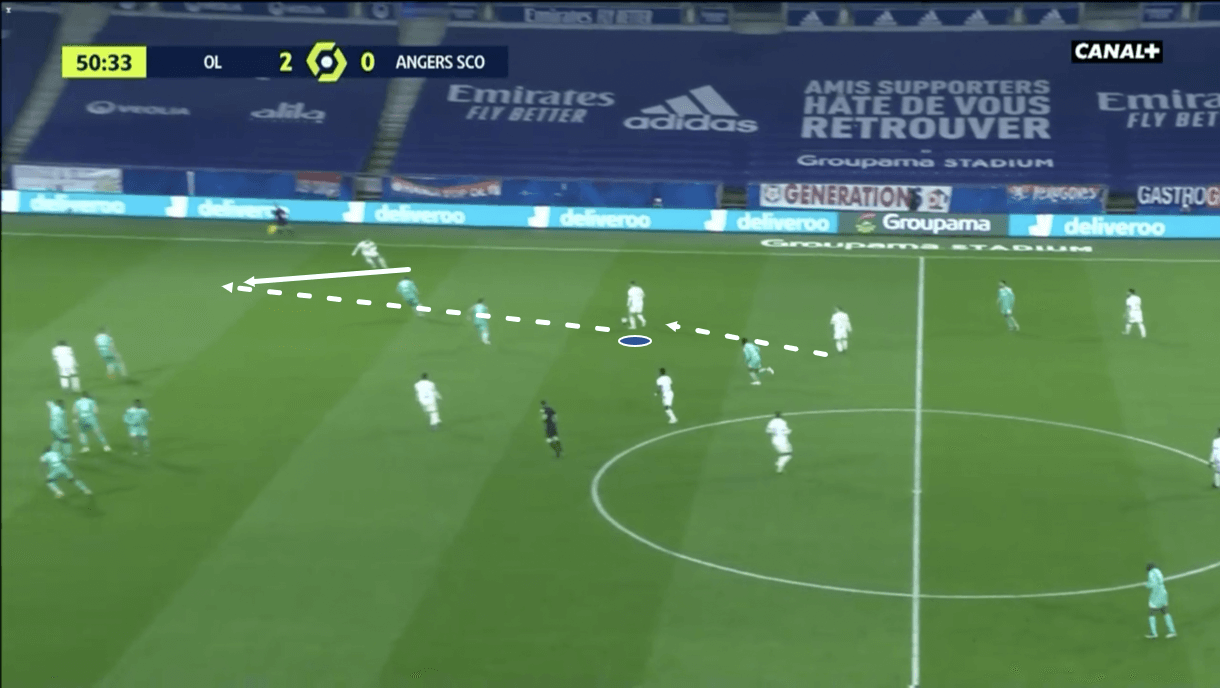
Guimarães’ line-breaking passing is also an important part of his game when his team is in transition to attack. Figure 15 shows an example of one such occasion when Lyon have just regained possession in midfield. Guimarães’ teammate won the ball back here, halting an opposition dribbler before quickly releasing to the Brazilian in space while occupying a typical right central midfielder position.
On receiving the ball, Guimarães quickly turned and was presented with the scene ahead of him — a disorganised opposition defensive shape transitioning back to defence with a few passing options available. One of those passing options for Guimarães was a runner on the right-wing attacking space behind the opposition’s backline. After turning, getting his head up and spotting this runner, Guimarães sliced the opposition open by threading a beautiful through pass between the defenders ahead of him and into the runner’s path, sending him off into the space behind the backline.
As play moves on from here, we see Lyon progress to attacking the opposition’s box. This shows how Guimarães’ on-the-ball quality which we’ve analysed in detail so far can be a great asset for his team during the transition to attack, and not just settled periods of possession. The transition to attack is always a dangerous phase of play so Guimarães’ passing quality is particularly useful when he can be found in space at the right time, as was the case here when he sent a teammate off into a lot of space.
Defensive contribution
The 24-year-old’s well-roundedness doesn’t end with his on-the-ball qualities but is a trait that pervades his all-around game — including his defensive contribution. Granted, Guimarães doesn’t offer a lot aerially and in central midfield, this can be seen as a weakness in terms of regaining possession from opposition goal-kicks and potentially being targeted with long balls. However, just as with his on-the-ball abilities where we criticised his shooting and shot selection at times but little else, it’s difficult to pick holes in Guimarães’ game and that includes his defensive game.
Firstly, the Brazilian has made 9.97 successful defensive actions per 90 this season, ranking very highly among Ligue 1 central midfielders / holding midfielders with at least 400 minutes to their name this term. He’s also engaged in a relatively high 9.22 defensive duels per 90, while retaining an equally impressive 66.22% success rate. Furthermore, per Statsbomb via FBRef, when compared with other midfielders from Europe’s top-five leagues, Guimarães ranks in the 96th percentile for tackles, 98th percentile for tackles won, 99th percentile for tackles in the middle third and 94th percentile for successful pressures.
Guimarães is very comfortable playing as an aggressive midfielder in defensive phases. He loves to be proactive about regaining possession and is effective at pressing on the front foot. His pace, acceleration, agility and balance — all of which are useful for him when dribbling — all come in handy when pressing on the front foot too as does his awareness and alertness as he needs to react to valuable pressing triggers like a heavy touch or a loose pass to initiate his press while also being ready and able to change direction as the opposition try to evade his pressure via passes or dribbling.
The Brazilian thrives when pressing on the front foot thanks to his abundance of qualities like those mentioned above. However, as I discussed in a recent article detailing Lyon’s defensive strategy and tactics, with the backline typically playing a more reactive role, Guimarães is often tasked with applying backwards pressure, which calls his willingness and motivation to track back, chase players down and fight for the ball after it’s already progressed past him into play. This puts a strain on different mental attributes as well as physical and technical attributes. The Lyon man needs to remain aware of movement behind him even though he loves to press aggressively high up the pitch on the front foot. This requires a different kind of discipline, as well as a different kind of awareness and alertness than previously discussed. Additionally, a different style of tackle is often required when pressing backwards than when pressing forwards.
However, this isn’t a concern for Guimarães who has operated very effectively in Lyon’s system this term — and that’s saying a lot given that Lyon, overall, have not been good enough this season. Guimarães has been a bright spark despite the overall gloominess of Les Gones’ season, though, which is a credit to him and his quality.
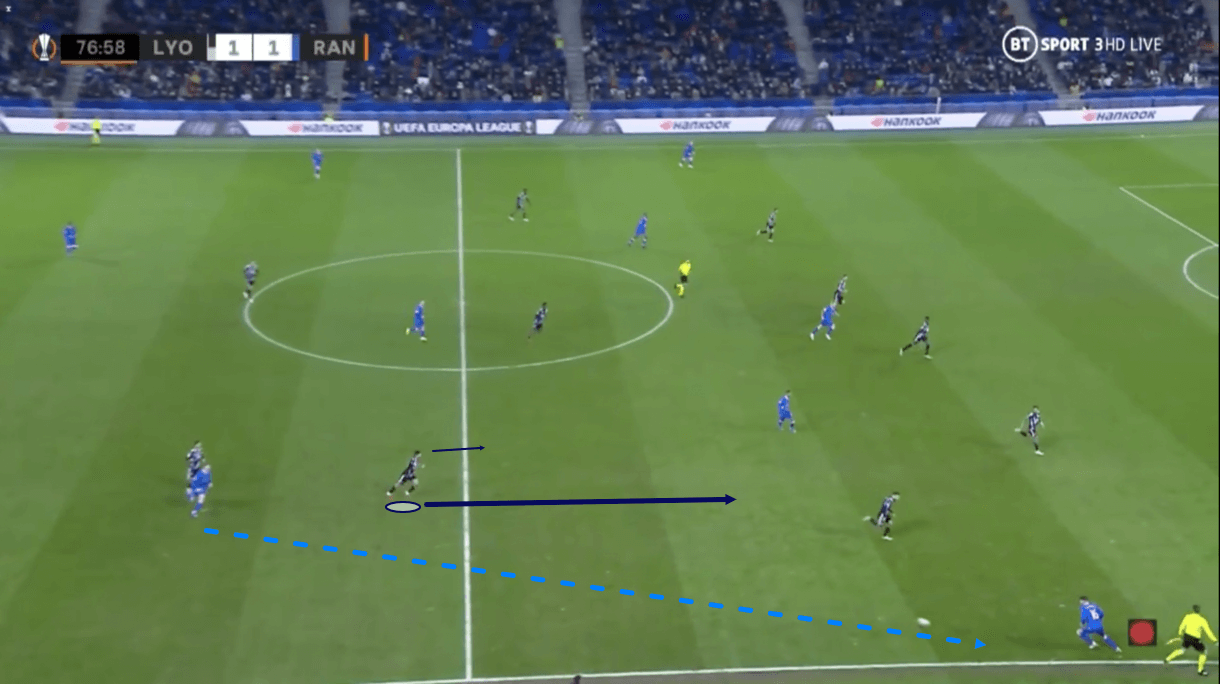
We see an example of Guimarães’ backwards pressing quality in figures 16-17. Firstly, in figure 16, we pick up play with Lyon’s UEFA Europa League opponents Rangers having just progressed from the back to the right-wing. Before this image, Guimarães was drawn upfield to press the previous ball carrier but as the ball is released, he gets his head up to spot a Rangers attacker moving into the space he’s vacated in central midfield. This attacker is threatening to link up with the receiver on the right wing to exploit this space and attack Les Gones’ retreating backline from a vulnerable spot.
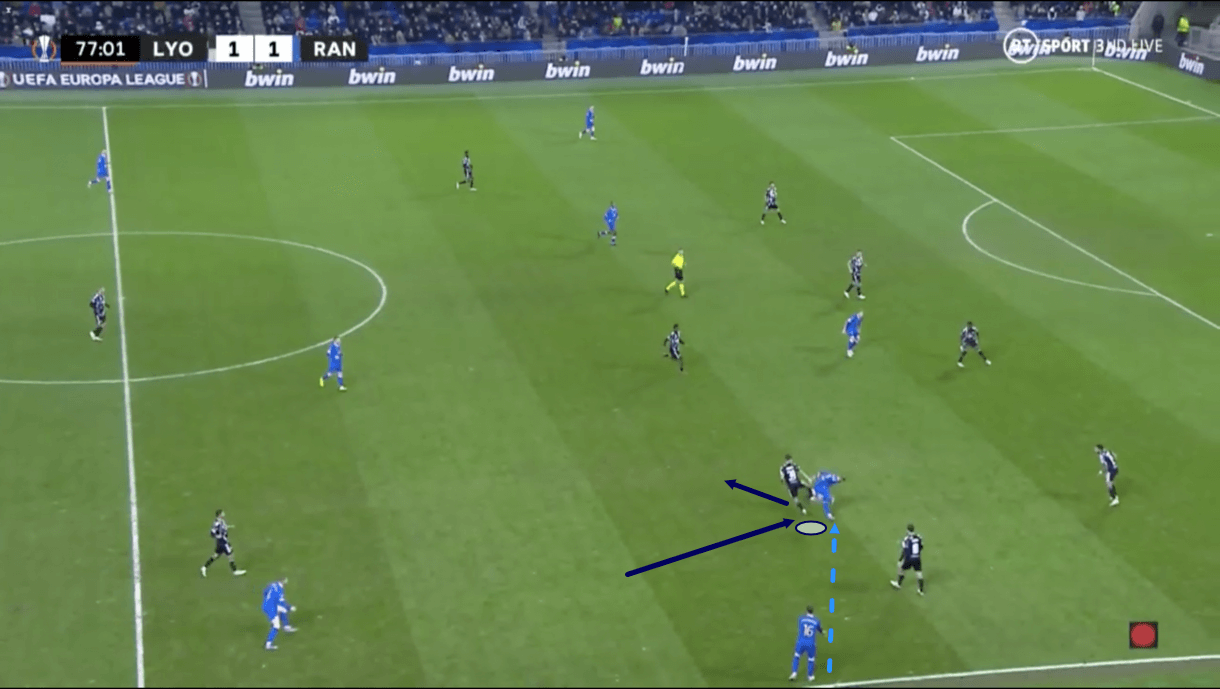
The ball is ultimately played to the attacker from the wide man just before figure 17. However, as we see in figure 17, Guimarães diligently covered all of the space between him and the attacker to successfully contest the defensive duel and regain possession for Lyon just on the edge of their own third. So, what could’ve been a dangerous attack for Lyon to defend was dealt with fairly early by Guimarães thanks to his diligent backwards pressure.
The midfielder’s strong mentality is evident from this passage of play, as is his physical and technical defensive qualities. He’s not afraid of getting into physical confrontations as we see here where he — in a controlled manner — drove his shoulder into the attacker to off-balance them before nicking the ball away and kickstarting a counterattack for his own side. It’s common to see Guimarães having to apply backwards pressure like this under Peter Bosz and as is evident from his stellar defensive statistics, he’s operating very well in this role. The same can’t be said for all of this Lyon side, but Guimarães has been very good.
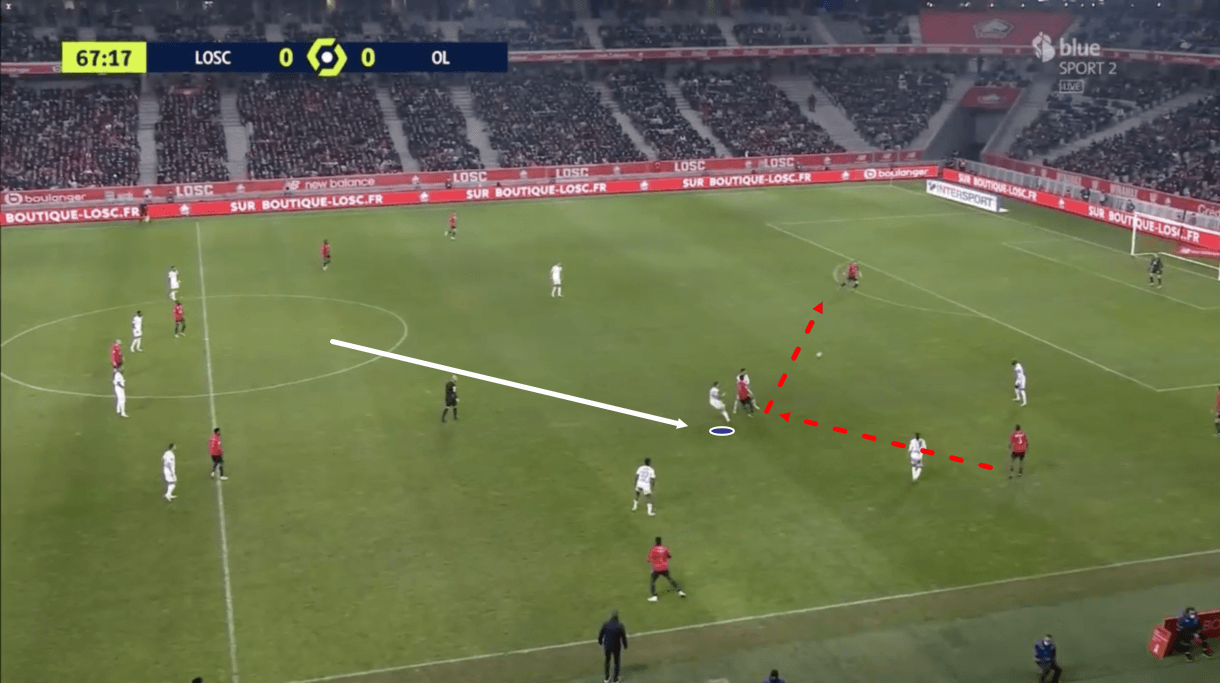
One potential area of improvement for Guimarães without the ball is that he can sometimes be overly aggressive. This is something that puts me off the idea of him playing as a sole holding midfielder, as you’d typically want that player to be more disciplined than Guimarães has shown he can be during defensive phases. Even in a double-pivot, however, there are times when Guimarães has been overly eager to regain possession, resulting in needlessly wasted energy and fairly easy progression for the opposition. Take figures 18-19 as an example.
Firstly, in figure 18, we see that Guimarães has just departed from his typical, central midfield position to apply pressure from behind to an opposition player receiving a pass. Guimarães got in a good position to prevent the player from turning and potentially even dispossess them, but the receiver was able to send the ball back to the right centre-back despite the presence of multiple Lyon players around him, including Guimarães. This left the Brazilian caught out of position, having essentially spent all of that energy for nothing and actually put himself in a worse position thanks to the opposition passer’s good work.
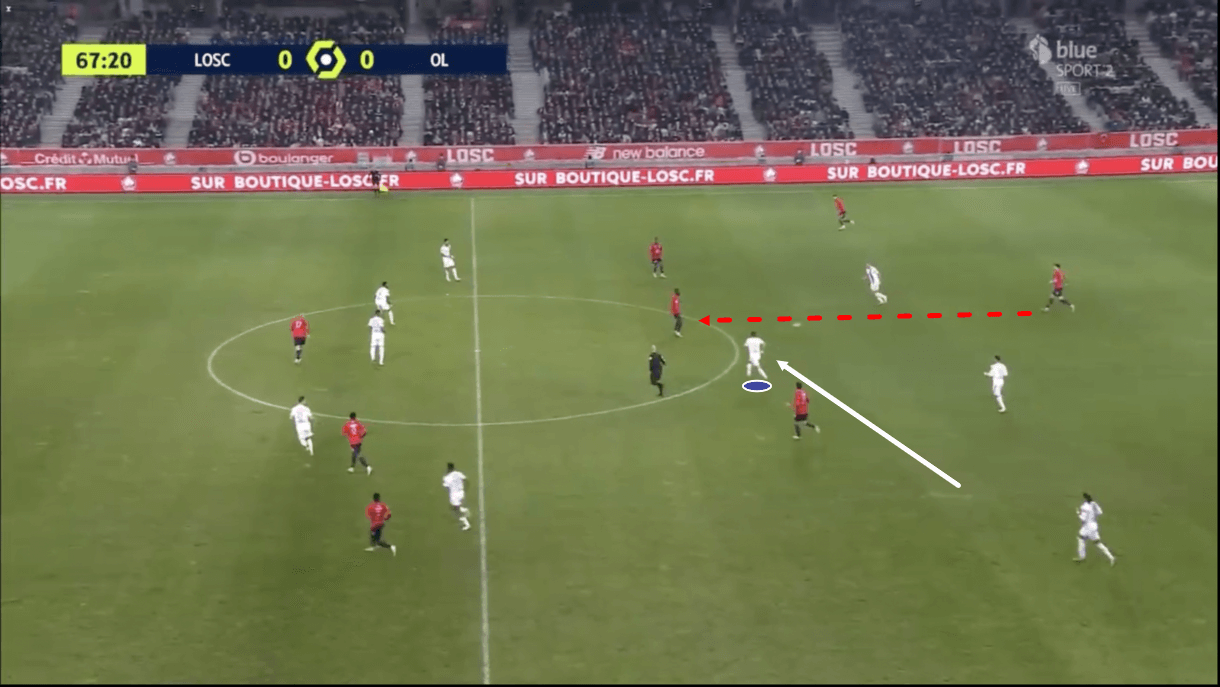
As play moves on into figure 19, we see that Guimarães is now tasked with tracking all the way back to try and get to the opposition attacker who’s dropped into the space he vacated in central midfield. However, despite Guimarães’ efforts, the right centre-back who received the ball from the midfielder previously was able to progress the ball to the attacker occupying the space Guimarães vacated and from here, the opposition were able to progress further upfield, putting some pressure on Lyon’s backline and really highlighting how Guimarães’ overly aggressive play can be exploited.
Of course, the midfielder doesn’t always defend too aggressively but he is, in general, an aggressive player rather than a passive one who looks to find confrontations in defensive phases. He’s an energetic midfielder who loves to find defensive duels but sometimes, it’d be more beneficial for him to just take an extra couple of seconds before pressing to consider if it’s really the best move. As we saw in figure 18, plenty of other Lyon shirts surrounded the ball carrier and Guimarães’ presence wasn’t incredibly necessary at that moment, so his energy may not have been best spent bursting forward to apply pressure in the first place. In hindsight, which is always 20/20, we can definitely say it wasn’t and we can see that Lyon were, ultimately, punished.
Guimarães can improve his decision-making in defensive phases, work on his defensive positioning and ability to defend by cutting off passing lanes to take his defensive game forward in the future. This could also help him to make more interceptions, as this is an area he’s currently not performing incredibly in. Guimarães’ aggression is partly down to his role in the squad and also his own personal preference but I’ve not seen a lot to suggest he’s got more disciplined defending in his locker if required to play in that way, which is a limitation he could make some progress with.
Conclusion
To conclude this tactical analysis and scout report, however, I maintain the belief that Guimarães is an excellent all-around box-to-box midfielder both on and off the ball, in and out of possession, with very few evident weaknesses. He’s a triple threat in terms of dribbling, passing and defensive contribution — particularly in terms of pressing, tackling and aggressive defending for the latter.
On the ball, Guimarães is an excellent asset in all offensive phases, thanks to his comfortability on the ball and useful physical traits to go with his technical and mental capabilities. He’s an excellent dribbler and passer which are skills he uses to progress the ball upfield and add threat to his side, while these qualities also come in very useful for splitting the opposition’s shape open and playing his team into the final third. Physically, Guimarães is also very well-rounded with good speed, acceleration and deceptively impressive strength.
Two years ago, I likened Guimarães to Chelsea’s Mateo Kovačić and I feel this is still as apt a comparison as ever. I’m a big fan of this midfielder and think his future definitely lies at the very top of the European game.





Comments